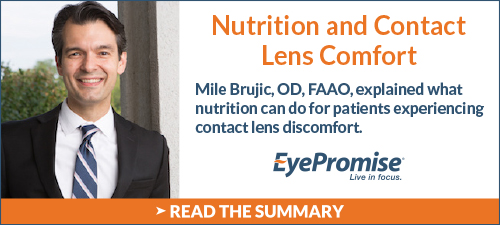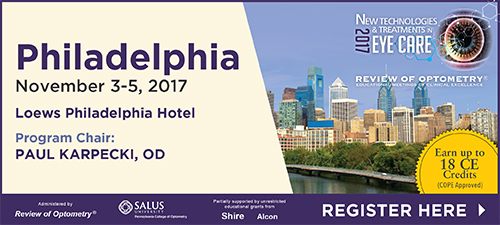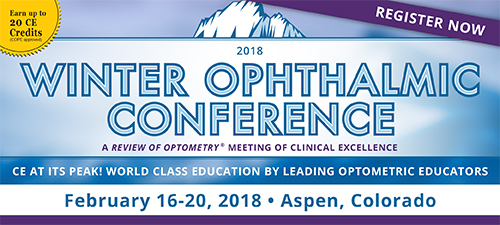
A
weekly e-journal by Art Epstein, OD, FAAO
Off the Cuff: The Art of Selling
While death and public speaking rank among the greatest fears for many, I suspect that fear of selling tops the list for most ODs. No matter if the recommendation is good for the patient, the idea of actually selling something has many ODs silently whimpering and avoiding eye contact with their patients.
While the art of selling is often studied and frequently discussed, sometimes the true art of selling is letting someone else do it for you.
|
|||||

|
||
| Scleral Contact Lenses for the Management of Complicated Ptosis | ||||
Three patients (five eyes) with ptosis resulting from levator dehiscence due to long-term rigid gas permeable contact lens wear for keratoconus, phthisis bulbi and myopathy due to Kearns-Sayre syndrome were identified during a two-year period. They were fitted with scleral contact lenses to provide cosmesis and simultaneous vision correction where applicable, by lifting the upper eyelid with the bulk of the lens.
The scleral contact lenses provided comfortable wear and significantly improved cosmesis, as palpebral aperture and marginal reflex distance were increased. In addition, visual acuity subjectively and objectively improved. Two patients opted for the scleral contact lenses, whereas the parents of the third patient, a 10-year-old girl with Kearns-Sayre syndrome, chose to undergo ptosis surgery due to handling issues of the scleral contact lenses. Researchers concluded that scleral contact lenses can be a useful addition to the treatment option for patients with complicated ptosis. |
||||
SOURCE: Katsoulos K, Rallatos GL, Mavrikakis I. Scleral contact lenses for the management of complicated ptosis. Orbit. 2017; Oct 20:1-7. [Epub ahead of print]. |
||||
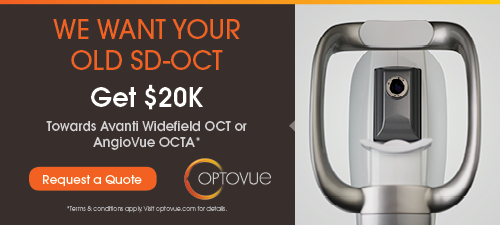 |
||
Anti-Vascular Endothelial Growth Factor Therapy for Myopic Choroidal Neovascularization |
||||
Myopic choroidal neovascularization (CNV) is one of the most vision-impairing complications in patients with pathologic myopia, authors wrote. It is also one of the most frequently encountered non-age-related macular degeneration causes of CNV and affects young patients in the working age group, they added. Fluorescein angiography (FA) and spectral-domain optical coherence tomography (SD-OCT) are generally indicated to confirm the diagnosis of active myopic CNV before initiation of treatment; without treatment, natural history studies have shown that the vision outcome can be very poor, authors wrote further.
More recently, a number of retrospective, prospective and Phase III, multicenter, randomized controlled trials have established the safety and efficacy of intravitreal anti-vascular endothelial growth factor (VEGF) agents for the treatment of myopic CNV. Long-term follow-up studies have found that some of the initial vision gained after intravitreal anti-VEGF therapy might not be maintained, owing to the presence and progression of chorioretinal atrophy (CRA) adjacent to the CNV, authors wrote. They suggested that further research on clinical and imaging characteristics might elucidate the prognostic factors that are crucial to optimizing the treatment and prevention of visual impairment associated with myopic CNV. |
||||
SOURCE: Ng DSC, Lai TYY, Cheung CMG, et al. Anti-vascular endothelial growth factor therapy for myopic choroidal neovascularization. Asia Pac J Ophthalmol (Phila). 2017; Oct 20. [Epub ahead of print]. |
||||
|
|||
| Alcohol Expectancies Longitudinally Predict Drinking and the Alcohol Myopia Effects of Relief, Self-Inflation and Excess | ||||
The alcohol myopia theory posits that alcohol consumption attenuates information processing capacity and that expectancy beliefs together with intake level are responsible for experiences in myopic effects (relief, self-inflation and excess). Adults (n=413) averaging 36.39 (SD=13.02) years of age completed the Comprehensive Effects of Alcohol questionnaire at baseline, followed by alcohol use measures (frequency and quantity) and the Alcohol Myopia Scale one month later. Three structural equation models based on differing construct manifestations of alcohol expectancies served to longitudinally forecast alcohol use and myopia.
In model 1, overall expectancy predicted greater alcohol use and higher levels of all three myopic effects. In model 2, specifying separate positive and negative expectancy factors—positive but not negative expectancy—predicted greater use. Furthermore, positive expectancy and use explained higher myopic relief and higher self-inflation, whereas positive expectancy, negative expectancy and use explained higher myopic excess. In model 3, the seven specific expectancy subscales (sociability, tension reduction, liquid courage, sexuality, cognitive and behavioral impairment, risk and aggression, and self-perception) were simultaneously specified as predictors. Tension reduction expectancy, sexuality expectancy and use contributed to higher myopic relief; sexuality expectancy and use explained higher myopic self-inflation; and risk and aggression expectancy and use accounted for higher myopic excess. Across all three predictive models, the total variance explained ranged from 12% to 19% for alcohol use, 50% to 51% for relief, 29% to 34% for self-inflation and 32% to 35% for excess. Investigators wrote that the findings indicated that the type of alcohol myopia experienced was a concurrent function of self-fulfilling alcohol prophecies and drinking levels. The interpreted measurement manifestation of expectancy yielded different prevention implications. |
||||
SOURCE: Lac A, Brack N. Alcohol expectancies longitudinally predict drinking and the alcohol myopia effects of relief, self-inflation and excess. Addict Behav. 2017; Oct 12. [Epub ahead of print]. |
||||
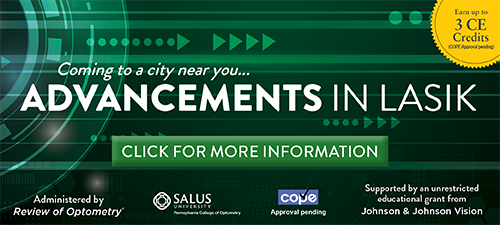 |
||
| News & Notes | |||||||||||||||
| AAOF Names 2017 VSP Global/FYi Doctors Scholarship Recipients The American Academy of Optometry Foundation announced the 2017 Practice Excellence Scholarship recipients. Nearly $200,000 will be distributed among 44 top-performing, fourth-year optometry students in the United States, Puerto Rico and Canada. Two students from each college of optometry were selected as recipients from nominations submitted by their institutions. Since 2000, VSP has provided nearly $2 million in scholarship support to hundreds of optometry students. The scholarships are funded through VSP Global’s Eyes of Hope Global Charitable Fund in collaboration with FYi Doctors in Canada (for Canadian recipients) and administered through the AAOF. View the recipients.
|
|||||||||||||||
Academy 2017 Attendance Exceeds Records, AAO Aids Puerto Rican Attendees
|
|||||||||||||||
| Study: Patients Using Rohto Dry-Aid Report All-day Relief of DED Ocular Signs & Symptoms Over the course of a day, Rohto Dry-Aid, a new, over-the-counter lubricant eye drop, demonstrated superior relief of discomfort associated with visual tasking activities and showed longer duration of symptomatic relief vs. a widely used ocular lubricant, according to a study published in Clinical Ophthalmology. This prospective, single-center, parallel-group study compared in a real-life setting the effects of Rohto Dry-Aid with a leading artificial tear brand in the United States in patients 18 years of age or older (n=80) diagnosed with mild to moderate dry eye disease over approximately 30 days. Read more.
|
|||||||||||||||
| Katena Acquires Rhein Medical Katena Products purchased Rhein Medical, a provider of ophthalmic surgical instruments and devices focused on the anterior segment surgical business, including cataract and refractive surgery, glaucoma and corneal procedures, and the ocular surface. Katena, an independently owned company, offers its products to more than 7,000 customers in the United States and around the world. Read more. |
|||||||||||||||
|
|||||||||||||||
|
|||||||||||||||
|
|||||||||||||||
|
Optometric Physician™ (OP) newsletter is owned and published by Dr. Arthur Epstein. It is distributed by the Review Group, a Division of Jobson Medical Information LLC (JMI), 11 Campus Boulevard, Newtown Square, PA 19073. HOW TO ADVERTISE |



